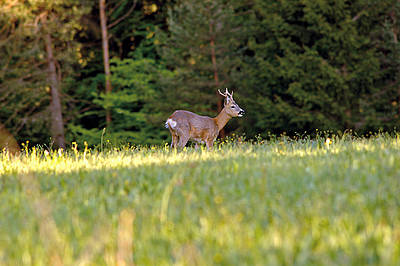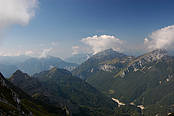Ungulates
Roebuck (Capreolus capreolus)
Habitat: the species lives in Europe and Asia up to and including China. In Italy it is widespread in the Venezie territories.
Identification: it is 60-70 cm in height up to the shoulder; its weight, assessed according to the procedure without the inner organs, is about 17-24 kg for the male and 14-20 kg for the female. It has a reddish brown coat and the younger members have light patches. Its horns, more correctly known as antlers, which are caducous, form when adult and the two main beams branch off into three antlers that reach a height of about 18-25 cm. Only the male have horns.
Reproduction: The Roebuck is usually solitary, or during winter, it lives in groups formed by the female mother with its fawns (usually two), accompanied by a young female without fawns, that is the offspring from the previous year.
Food: it feeds mainly on plants.
Chamois (Rupicapra rupicapra)
Habitat: in Italy it is found throughout the Alpine mountain range. It is present on the Balkans, the Carpathians, the Pyrenees, on the mountains of Asia Minor and the Caucasus.
Identification: they are about 80 cm in height up to the withers, 1.50 m in length, they have an elegant aspect, long legs, horns (the female, too), which curve at the ends. Its coat is even and rough over its entire body, not as thick and of a tawny colour during the summer period, and downy and of a brown colour during winter. The chamois is a very agile climber, it can jump up to 4 m in height and 7 m in length.
Reproduction: it lives in herds (headed by an elder female, while the adult males live in isolation or in groups of 2-3). The mating season is between October and December. After 150-180 days the female gives birth to one to three small chamois, between mid May and mid June.
Food: it feeds mainly on plants.
Deer (Cervus elaphus )
Habitat: it is widespread in the Palearctic and Nearctic region, with about 23 subspecies. In Italy it is relatively common, with a rather continuous distribution throughout the Venezie regions.
Identification: it is 120-150 cm in height to the shoulder; its weight, without its inner organs, reaches 100-180 kg for the male and 70-90 kg the female. The colour of its coat varies from reddish brown to grey-brown, depending on the subspecies and the season. The young deer have a coat with white speckles. The beams have a variable number of tines, from 8 to 14 in all (when adult) and are naturally caducous and only the male has them.
Reproduction: it lives in more or less numerous herds, depending on the nature of the territory. There are three types of maternal groups (more females with their fawns and off-spring that is a year old); unisexual males; mixed (during the mating season); some of them live solitary.
Food: it feeds on grass, leaves, musk and tree bark.
Steinbock (Capra ibex)
Habitat: it lives on the mountains even over 2000 m in altitude (it resists the cold very well); it was once common throughout the Alps.
Identification: it looks similar to a goat, about 1.50 m in length and 85 cm in height to the withers; its coat is reddish grey with a short mane. Both the male and female have horns but those of the female are smaller, ringed and curve back more. These animals are extremely agile.
Reproduction: it lives in flocks. The female gives birth to a single steinbock in May. The gestation period is from 150 to 160 days. The small steinbock are born between September and October.
Food: it feeds on lichen and aromatic herbs.








